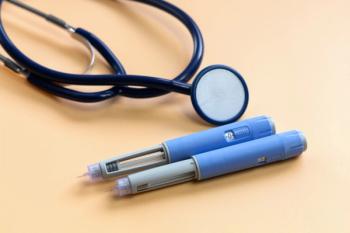
- October 2018 Diabetes
- Volume 84
- Issue 10
Make a Point of Preventing Insulin Pen Errors
Insulin education is a key component of diabetes management.
Insulin education is a key component of diabetes management. Compared with administration of insulin with a vial and syringe, patients often prefer pen devices, because of their ease of use and improved dosing accuracy.1 However, up to 75% of patients with diabetes do not administer or store insulin pens according to manufacturer recommendations.2 Improper use of pens can increase dosing errors, insulin degradation or expiration, and the risk of infection.3 Therefore, periodic education from health care professionals on how to correctly use pen devices is imperative for patients with diabetes.
Pen Device Errors
Preparing for Administration
Remind patients to attach a new needle before administering insulin. The results of one study show that 16% of patients reported leaving the needle attached to the pen device for 3 or more injections.2 Needle reuse can bend or break the tip and decrease lubrication, resulting in a more painful injection.4 In addition, it can lead to insulin contamination, lipohypertrophy (LH), and a loss of sterility.4 Once a new needle is attached, educate patients about appropriately removing needle caps. Some needles use a single outer cover (eg, auto shield) while other brands require the removal of 2 covers to expose the needle. In one published case, a provider discovered that a patient was removing the outer but not the inner cap, resulting in no insulin delivery for 6 months.5
Additional errors may occur, because of skipping the priming step or dialing the incorrect dose. Priming the device after attaching a new pen needle ensures that the pen works correctly and air bubbles are removed, which improves insulin dose accuracy. Yet, more than two-thirds of patients are not aware of the reason for priming and often skip this step.2 Visually impaired patients also may rely on audible clicks to dial up the dose. However, sound recordings show that certain pen devices produce louder clicks than others and make patients unsure as to whether they have selected the correct dose.6 In addition, with the availability of concentrated insulins in pen devices, it is important to properly educate individuals about the concentration that is delivered with each click.
Injection Technique
Although 79% of patients are aware of the need to rotate injection sites, just 23% follow an organized rotation system.7 They may experience poor glycemic control because of improper injection technique related to rotating the injection site, pinching the skin, releasing the dose, and holding the device in place. Rotation of the injection site can lessen the development of LH. Patients may not report symptoms suggestive of LH. In one study, 76% of patients denied experiencing LH although more than half were found to have it upon physical examination. Injecting into lipohypertrophic lesions can affect the absorption of insulin. Therefore, it is important to educate patients about the signs of LH and injection site rotation.
Patients may not be aware of the appropriate angle and technique to insert the pen needle. The International Scientific Advisory Board for the Third Injection Technique Workshop recommends inserting 4-, 5-, and 6-mm needles at a 90° angle. Longer needles should be injected with a skinfold or a 45° angle to prevent an intramuscular injection, which can cause erratic glucose absorption.8 Because using the entire hand risks lifting the muscle, which can lead to an intramuscular injection,9 the index finger and thumb should be used to lift the skin. It is a common misconception that patients who are obese with diabetes need longer needle lengths to penetrate the subcutaneous tissue. However, results of studies evaluating skin composition show that shorter needle lengths are just as efficacious and reduce the risk of intramuscular administration in these patients, too.9
When patients are ready to dispense their medications, there should be clear directions on where to push the plunger button. There have been case reports of patients dialing the appropriate dose and correctly inserting the needle but twisting the dose back to zero rather than pushing the button.5,10
Finally, the patient should be educated about keeping the device in place for 5 to 10 seconds after dose administration. Insulin may continue to flow out of the pen for several seconds after pushing the button, and higher doses of insulin can contribute to longer transit times.11 However, up to 50% of patients do not hold the pen device in place for the time specified by the manufacturer.2
Storage
Unopened insulin pens should be refrigerated until the expiration date and stored at room temperature once in use. Storage at room temperature prevents air bubbles, which can form when the insulin and device expand and contract during a temperature change.11 Most insulin pens should be protected from heat and light and stored at room temperatures below 86°F (<30°C). One exception is insulin glulisine, which must be stored at room temperature not exceeding 77°F (£25°C).11 Discard dates differ, ranging from 14 to 42 days, and failure to appropriately discard may lead to insulin degradation or expiration.2
Conclusion
The findings of several studies show that insulin administration with pen devices offers many advantages over syringes, including better patient adherence and satisfaction, ease of use, and dosing accuracy. However, unawareness of correct instructions for insulin pen administration and storage can lead to suboptimal glucose control. Therefore, it is important for health care professionals to provide initial and periodic education to patients with diabetes who use insulin pen devices.
Lourdes Cross, PharmD, BCACP, CDE, is an assistant professor of clinical and administrative sciences at the Sullivan University College of Pharmacy in Louisville, Kentucky.
References
- Brunton S. Initiating insulin therapy in type 2 diabetes: benefits of insulin analogs and insulin pens. Diabetes Technol Ther. 2008;10(4):247-256. doi: 10.1089/dia.2008.0287.
- Mitchell VD, Porter K, Beatty SJ. Administration technique and storage of disposable insulin pens reported by patients with diabetes. Diabetes Educ. 2012;38(5):651-658.
- Uslan MM. Analysis: beyond the “clicks” of dose setting in insulin pens. Diabetes Technol Ther. 2005;7(4):627-628.
- Poudel RS, Shrestha S, Piryani RM, Basyal B, Kaucha K, Adhikari S. Assessment of insulin injection practice among diabetes patients in a tertiary healthcare centre in Nepal: a preliminary study. J Diabetes Res. 2017;2017:8648316. doi: 10.1155/2017/8648316.
- Truong TH, Nguyen TT, Armor BL, Farley JR. Errors in the administration technique of insulin pen devices: a result of insufficient education. Diabetes Ther. 2017;8(2):221-226. doi: 10.1007/s13300-017-0242-y.
- Asakura T, Seino H. Assessment of dose selection attributes with audible notification in insulin pen devices. Diabetes Technol Ther. 2005;7(4):620-626.
- Frid A, Hirsch L, Gaspar R, et al. The third injection technique workshop in athens (TITAN). Diabetes Metab. 2010;36(suppl 2):S19-S29. doi: 10.1016/S1262-3636(10)70003-3.
- Frid A, Hirsch L, Gaspar R, et al; Scientific Advisory Board for the Third Injection Technique Workshop. New injection recommendations for patients with diabetes. Diabetes Metab. 2010;36(suppl 2):S3-S18. doi: 10.1016/S1262-3636(10)70002-1.
- Frid AH, Kreugel G, Grassi G, et al; Scientific Advisory Board for the Third Injection Technique Workshop. New insulin delivery recommendations. Mayo Clin Proc. 2016;91(9):1231-1255. doi: 10.1016/j.mayocp.2016.06.010.
- Shah A, Sullivan MM, Rushakoff RJ. A new “twist” on insulin pen administration errors. Endocr Pract. 2014;20(6):617.
- Pearson TL. Practical aspects of insulin pen devices. J Diabetes Sci Technol. 2010;4(3):522-531.
Articles in this issue
about 7 years ago
There Is an App for Thatabout 7 years ago
Obesity Is a Weight-Loss Maintenance Problemabout 7 years ago
Valproic Acid and Carbapenem Antibiotics Interactionabout 7 years ago
Saturated Fat and Cardiovascular Diseaseabout 7 years ago
An Unsafe Practice: Reuse of Prefilled Saline Flushabout 7 years ago
Nonprescription Products for Proper Diabetic Foot Careabout 7 years ago
Provision of Diabetes Sick-Day Plans in the Community Pharmacyabout 7 years ago
Kentucky Bans Pharmacy Gag Clausesabout 7 years ago
Handling Prior Authorization Requests: Revisited on AppealNewsletter
Stay informed on drug updates, treatment guidelines, and pharmacy practice trends—subscribe to Pharmacy Times for weekly clinical insights.


















































































































































































































